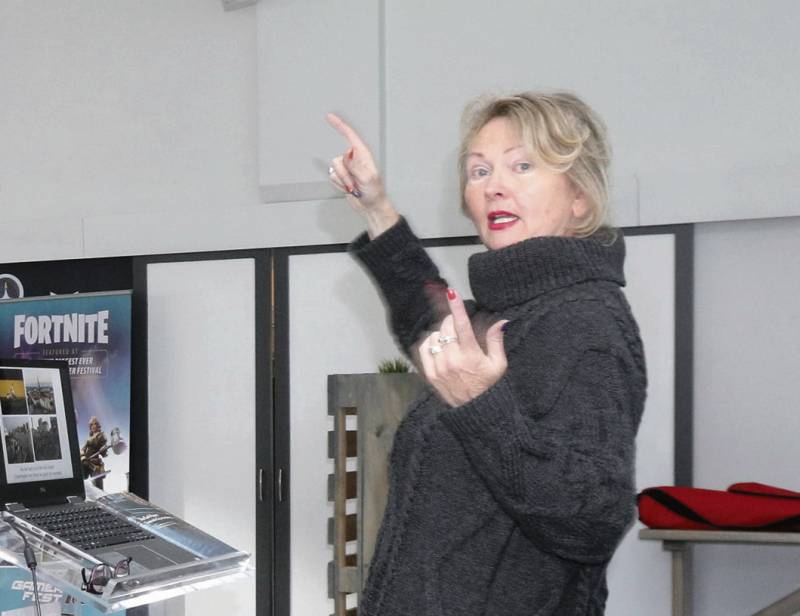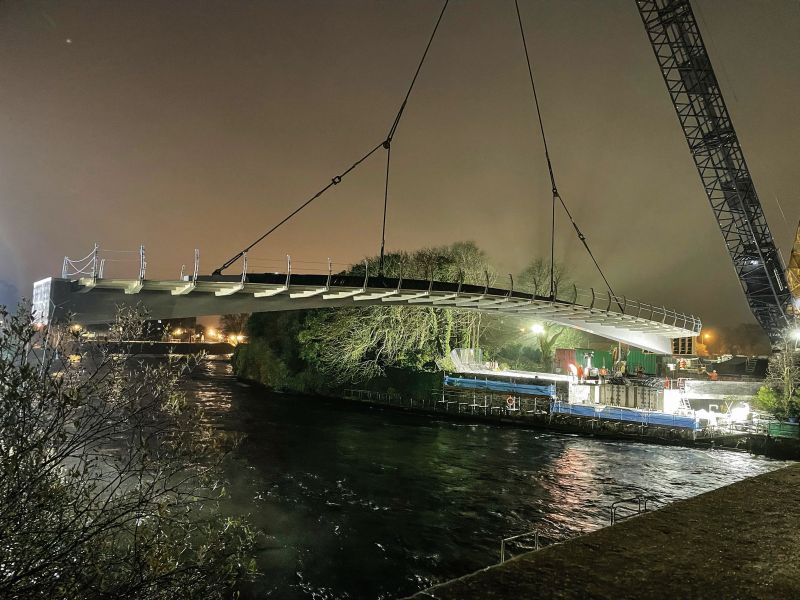CITY TRIBUNE
Top architect brands Galway as ‘dominated by cars’

An internationally-renowned architect has said that Galway City is lacking vision and is dominated by cars, with motorists getting priority over pedestrians and cyclists.
In addition, Angela Brady, former president of the Royal Institute of British Architects and chairperson of the Royal Institutes of the Architects of Ireland (RIAI), agreed that the authority most benefiting financially from car parking in the city should not be the same one investing in transport and urban planning.
“Walking around today, it was blatantly obvious that there was a conflict of interest. That needs to be separated – they should not be the same,” the presenter of TV show, Designing Ireland, said at the Galway Environmental Network’s (GEN) inaugural event in the Porter Shed on Saturday.
“If you allow car parking in the city centre, you will kill it. There are a lot of cities that have cut the amount of cars coming in, but it’s a matter of also increasing public transport in order for a city to work.
“I can be critical, because I don’t live here – this is a fantastic city, but it lacks vision,” she said, adding that the decisions about the future of Galway were not being made by those who would ultimately be affected by them – the people.
“To get this vision, you need to have a city architect with vision and a budget, with the roads engineer somewhere out here (well removed) because roads are killing this city, and killing its surroundings. There are much more important things than the 1960’s idea, where the city engineer ruled with no public consultation.
“You can make one or two bad decisions, and your city is finished, because people haven’t had a chance to have their say. You don’t not want to lose that chance of making Galway an absolutely vibrant and onward-moving city.
“The most successful cities are those that intensify, and don’t have ribbon development spread out, which brings all of the problems of traffic coming back in (to the centre) again. Traffic is a major problem here, I can see it as a pedestrian.”
Ms Brady pointed out that successful cities put pedestrians first. Galway was a car-dominated city, she said, with car parks using the best spaces.
“We have to play down the car, and have good public transport, good walkways, good cycle paths, good waterways – and use them.
“The harbour front is crying out for the right kind of development, the right type of urban structure but, in order to make a city great, you have to have your say as a member of the public, as a Galwegian, as somebody who is going to be affected by whatever decisions are made. The best cities are the ones that have got community consultation at the heart of every large decision that is made in their city. Without it, huge mistakes can be made, no matter what city you are talking about.
“We as professions, as clients, architects, or politicians cannot think that we know we will get something right, unless you ask the people who are the stakeholders – the residents, the public, the businesses – people make a city, and without their say, the city won’t work as well as it could, and it causes confrontation. You will get negativity when people haven’t had their say and I fear that in Galway there is not enough public consultation.”
Comparing Cork and Galway, Ms Brady said that the latter had turned its back on “the most beautiful waterfront.”
“It’s now time for change, to go and face the Atlantic, open up the waterfront, because water brings such life and joy to so many places.”
Referencing successful building projects in China, Scandinavia, and London, she said that, as architects, they must consider the social life of buildings, and any spaces in between.
On a project for Ballymore, a large Irish developer, on a site in the Isle of Dogs, East London, she was involved with designing 200 homes in a mixed-housing development. There were no cars allowed on site, and only a minimal number underground, with the strategy by the planners that only one-in-three homes had any car parking space in this development.
“Because they were beside public transport, there were very good policies to say: you don’t need a car,” she said.
Encouraging Mayor of Galway, Niall McNeilis, to start a no-car policy in Galway City Centre on a trial basis, she referenced the example shown in Clonakilty, Co Cork, which actually has its own Town Architect.
“This is a great success story, because the people have said: ‘We don’t want Astna Square to have cars parked all over it, how about we put people first’. The cars may pass, but a pedestrian has priority. Now, people go there, shops are thriving, people sit out in the square, as they would in Italy.
“They have festivals, where they close roads, and have the festivals where no cars go down, and they have a weekend of fun. It’s good for people’s souls, and the soul of the town.”
Ms Brady was one of a number of speakers at the Galway Environmental Network’s inaugural event last week, which was chaired by Daibhí MacDomhnaill, a Galway-native and a leading expert in urbanism in Ireland.
Other speakers included Frank Monahan, from Architecture on the Edge; Professor Kevin Leyden, Joint Director, Creative, Liveable and Sustainable Communities Research Cluster Leader, Whitaker Institute; Professor Ulf Strohmayer, Professor of Geography, NUI Galway; Patrick Faherty, Assistant Planning/Projects Officer, NUI Galway; and Rosie Webb, Senior Architect in Economic Development at Limerick City and County Council.
“The formation of the GEN, and its close links with Galway City and County Councils, the Galway City Community Network and many other established organisations will ensure that the environment in Galway now has a strong voice in the decision-making process at all levels,” said Caroline Kelly Stanley, best known for her work in promoting Merlin Woods.
■ To get involved with Galway Environmental Network, email galwayenvironmentalnetwork@gmail.com
CITY TRIBUNE
Galway ‘masterplan’ needed to tackle housing and transport crises

From the Galway City Tribune – An impassioned plea for a ‘masterplan’ that would guide Galway City into the future has been made in the Dáil. Galway West TD Catherine Connolly stated this week that there needed to be an all-inclusive approach with “vision and leadership” in order to build a sustainable city.
Deputy Connolly spoke at length at the crisis surrounding traffic and housing in Galway city and said that not all of the blame could be laid at the door of the local authority.
She said that her preference would be the provision of light rail as the main form of public transport, but that this would have to be driven by the government.
“I sat on the local council for 17 years and despaired at all of the solutions going down one road, metaphorically and literally. In 2005 we put Park & Ride into the development plan, but that has not been rolled out. A 2016 transport strategy was outdated at the time and still has not been updated.
“Due to the housing crisis in the city, a task force was set up in 2019. Not a single report or analysis has been published on the cause of the crisis,” added Deputy Connolly.
She then referred to a report from the Land Development Agency (LDA) that identified lands suitable for the provision of housing. But she said that two-thirds of these had significant problems and a large portion was in Merlin Park University Hospital which, she said, would never have housing built on it.
In response, Minister Simon Harris spoke of the continuing job investment in the city and also in higher education, which is his portfolio.
But turning his attention to traffic congestion, he accepted that there were “real issues” when it came to transport, mobility and accessibility around Galway.
“We share the view that we need a Park & Ride facility and I understand there are also Bus Connects plans.
“I also suggest that the City Council reflect on her comments. I am proud to be in a Government that is providing unparalleled levels of investment to local authorities and unparalleled opportunities for local authorities to draw down,” he said.
Then Minister Harris referred to the controversial Galway City Outer Ring Road which he said was “struck down by An Bord Pleanála”, despite a lot of energy having been put into that project.
However, Deputy Connolly picked up on this and pointed out that An Bord Pleanála did not say ‘No’ to the ring road.
“The High Court said ‘No’ to the ring road because An Bord Pleanála acknowledged it failed utterly to consider climate change and our climate change obligations.
“That tells us something about An Bord Pleanála and the management that submitted such a plan.”
In the end, Minister Harris agreed that there needed to be a masterplan for Galway City.
“I suggest it is for the local authority to come up with a vision and then work with the Government to try to fund and implement that.”
CITY TRIBUNE
Official opening of Galway’s new pedestrian and cycle bridge

The new Salmon Weir pedestrian and cycle bridge will be officially opened to the public next Friday, May 26.
Work on the €10 million bridge got underway in April 2022, before the main structure was hoisted into place in early December.
A lunchtime tape-cutting ceremony will take place on Friday, as the first pedestrians and cyclists traverse the as-yet-unnamed bridge.
The Chief Executive of Galway City Council, Brendan McGrath, previously said the bridge, once opened, would remove existing conflicts between pedestrians, cyclists and traffic “as well as facilitating the Cross-City Link public transport corridor over the existing 200-year-old bridge”.
The naming of the new bridge has been under discussion by the Council’s Civic Commemorations Committee since late last year.
One name that has been in the mix for some time is that of the first woman in Europe to graduate with an engineering degree – Alice Perry.
Ms Perry, who was from Wellpark, graduated from Queen’s College Galway (now University of Galway) in 1906. The university’s engineering building is named in her honour.
The bridge was built by Jons Civil Engineering firm in County Meath and was assembled off-site before being transported to Galway. Funding for the project was provided in full by the National Transport Authority and the European Regional Development Fund.
(Photo: Sheila Gallagher captured the city’s new pedestrian footbridge being raised on the south side of the Salmon Weir Bridge in December. It will officially open next Friday, May 26).
CITY TRIBUNE
Minister branded ‘a disgrace’ for reversing land rezoning in Galway City

From the Galway City Tribune – Minister of State for Local Government and Planning, Kieran O’Donnell was labelled a “disgrace” for overturning councillors’ decisions to rezone land in the new City Development Plan.
Minister O’Donnell (pictured) confirmed in a letter to Council Chief Executive Brendan McGrath last week that he was reversing 25 material alternations made by councillors to the CDP 2023-29. He made the decision on the advice of Office of Planning Regulator (OPR).
Minister O’Donnell directed that 14 land parcels that were subject to land-use zoning changes by councillors as part of the Material Alterations to the Draft CDP should be reversed.
He directed that a further 11 land parcels in the city should become “unzoned”.
The Minister found that the CDP had not been made in a manner consistent with recommendations of the OPR, which required specific changes to the plan to ensure consistency with the national planning laws and guidelines.
At last week’s Council meeting Cllr Eddie Hoare (FG) asked for clarity on the process by which councillors could rezone the lands that had been changed by the Minister’s direction.
Cllr Declan McDonnell said, “What he [Minister O’Donnell] has done is an absolute disgrace”.
And he asked: “Do we have to have another development plan meeting to deal with it?”
Both Cllrs Hoare and McDonnell wondered what would become of the lands that were rezoned or unzoned by the ministerial direction.
Mr McGrath said the Council had put forward an argument in favour of retaining the material alterations in the plan, but ultimately the Minister sided with OPR.
He said if councillors want to make alterations to the new plan, they could go through the process of making a material alteration but this was lengthy.
The Save Roscam Peninsula campaign welcomed the Minister’s decision.
In a statement to the Galway City Tribune, it said the direction would mean the Roscam village area on the Roscam Peninsula will be unzoned and a number of land parcels would revert back to agriculture/high amenity.
A spokesperson for the campaign said: “the material alterations made by city councillors following lobbying by developers continued the long-standing practice of councillors facilitating a developer-led plan rather than an evidence- and policy-based plan that meets the needs of the city.
“The Minister’s direction is an important step in restoring confidence in the planning system. It is clear from the City Council’s own evidence on future housing projections that there was no requirement to zone these lands for residential purposes in order to meet the needs of the targeted population increase up to 2029,” the spokesperson added.















